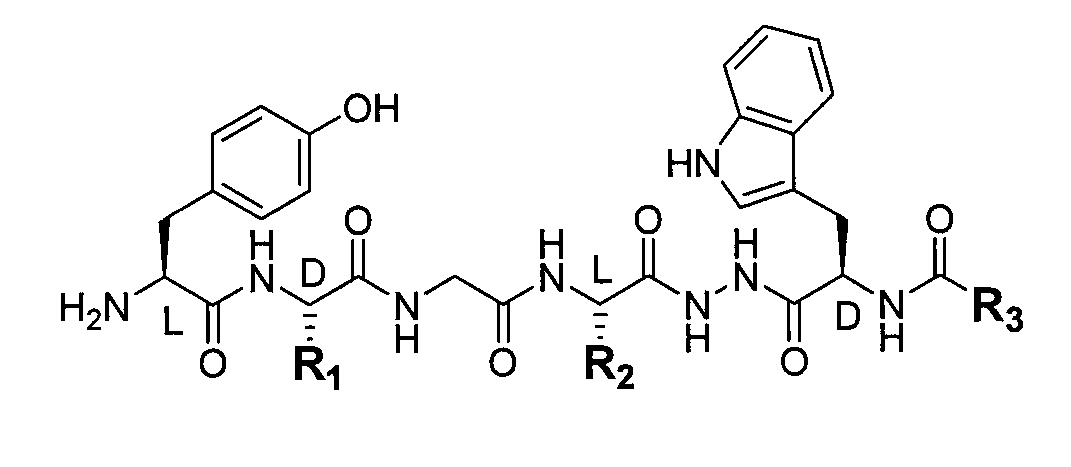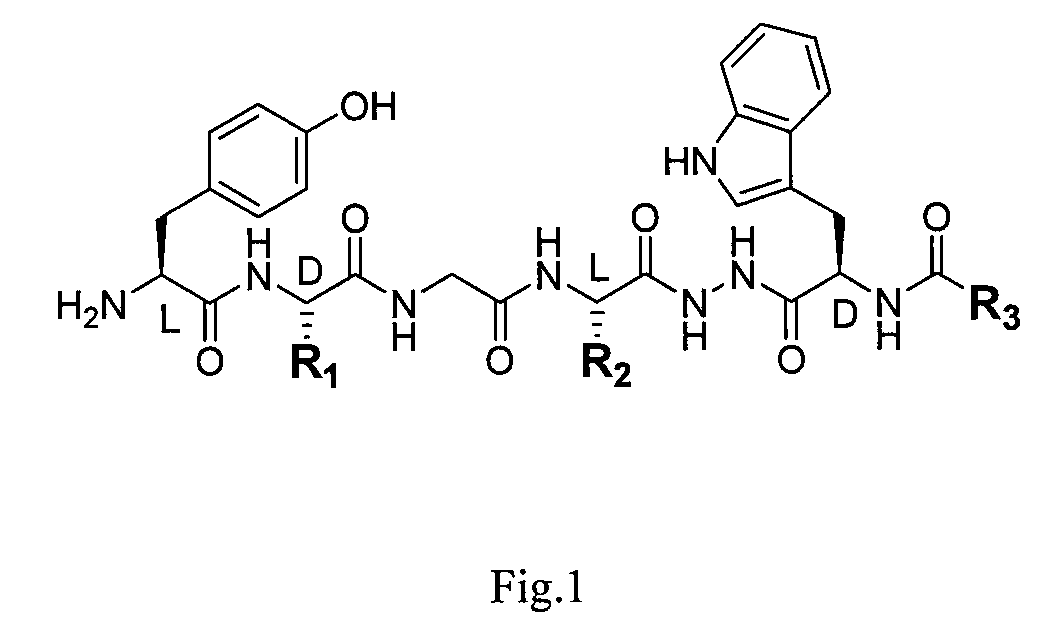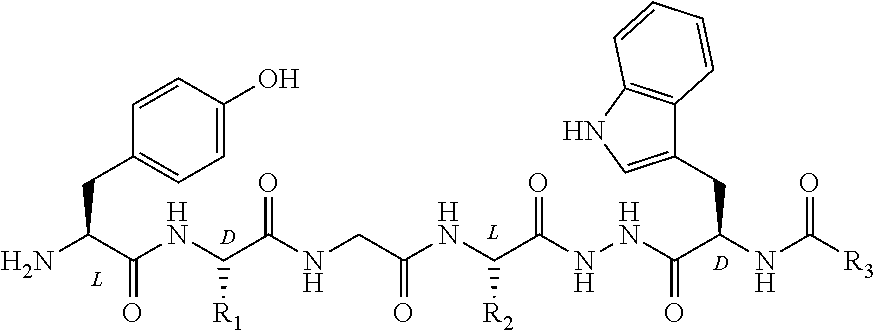Method of producing a novel opioid peptide
a peptide and opioid technology, applied in the direction of peptide/protein ingredients, peptide/protein components, tetrapeptide ingredients, etc., can solve the problems of undesirable side effects series, and achieve the effect of increasing the analgesic activity of the peptide analogue, conserving or increasing the analgesic activity
- Summary
- Abstract
- Description
- Claims
- Application Information
AI Technical Summary
Benefits of technology
Problems solved by technology
Method used
Image
Examples
example i
[0028]T-Butyloxycarbonyl-tyrosyl-D-alanyl-glycyl-phenylalanine (Boc-Tyr-D-Ala-Gly-Phe) (10 mmoles) and benzoxycarbonyl-D-tryptophanyl)-hydrazide (Cbz-D-Trp-NHNH2) (10 mmoles) as well as succinic acid hydroxyimide (HO-Su) (12 mmoles) were dissolved in dimethylformamide (DMF) (40 cm3). Following cooling to 0-5° C., the reaction mixture was supplemented with dicyclohexylcarboxyimide (10 mmoles). The reaction was stirred for 1 hour at a temperature of 5° C., and then for 12 hours at room temperature (20-25° C.). Next, the precipitated dicyclohexylurea (DCU) was filtered out and rinsed twice in 10 cm3 DMF. The filtrate was combined with 100 cm3 of 5% acidic potassium carbonate (KHCO3). The precipitated Boc-Tyr-D-Ala-Gly-Phe-NHNH-(Cbz-D-Trp-) was filtered out and rinsed twice with 10 cm3 of 5% KHCO3, and then twice in 10 cm3 water. The precipitate was dried, and the resulting substance was pulverised and added to 50 cm3 of a concentrated hydrochloric acid and ethanol mixture (1:1). During...
example ii
[0030]T-Butyloxycarbonyl-tyrosyl-D-alanyl-glycyl-phenylalanine (Boc-Tyr-D-Ala-Gly-Phe) (10 mmoles) and salicyl-glycyl-D-tryptophanyl (Salic-Gly-D-Trp-NHNH2) (10 mmoles) as well as succinic acid hydroxyimide (HO-Su) (12 mmoles) were dissolved in dimethylformamide (DMF) (40 cm3). After cooling to 0-5° C., the reaction mixture was supplemented with dicyclohexylcarboxyimide (10 mmoles). The reaction was stirred for 1 hour at a temperature of 5° C., and then for 12 hours at room temperature (20-25° C.). Next, the precipitated dicyclohexylurea (DCU) was drained of and rinsed twice 10 cm3 DMF. The filtrate was mixed with 100 cm3 of 5% acidic potassium carbonate (KHCO3). The precipitated Boc-Tyr-D-Ala-Gly-Phe-NHNH-(Salic-Gly-D-Trp-) was filtered out, rinsed twice in 10 cm3 5% KHCO3, and then twice 10 cm3 water. The precipitate was dried and pulverised and then added to 50 cm3 of a concentrated hydrochloric acid / ethanol mixture (1:1). During the reaction, CO2 is released and the reaction pro...
example iii
[0032]t-Butyloxycarbonyl-tyrosyl-D-alanyl-glycyl-phenylalanine (10 mmoles) and alpha-methyl-4-(2-methylpropyl) benzenoacetyl-D-tryptophanyl)-hydrazide (10 mmoles) as well as succinic acid hydroxyimide (HO-Su) (12 mmoles) were dissolved in dimethylformamide (DMF) (40 cm3). After cooling to 0-5° C. dicyclohexylcarboxyimide (10 mmoles) was added to the reaction mixture. The reaction was stirred for 1 hour at a temperature of 5° C., and then for 12 hours at room temperature (20-25° C.). Next, the precipitated dicyclohexylurea (DCU) was drained off and rinsed twice in 10 cm3 DMF. The filtrate was mixed with 100 cm3 of 5% acidic potassium carbonate (KHCO3). The precipitate was filtered out, rinsed twice in 10 cm3 5% KHCO3, and then twice 10 cm3 water. The precipitate was dried and pulverised and then added to 50 cm3 of a concentrated hydrochloric acid / ethanol mixture (1:1). During the reaction, CO2 is released and the reaction product dissolves. After 30 minutes of stirring at room temper...
PUM
| Property | Measurement | Unit |
|---|---|---|
| temperature | aaaaa | aaaaa |
| temperature | aaaaa | aaaaa |
| affinity | aaaaa | aaaaa |
Abstract
Description
Claims
Application Information
 Login to View More
Login to View More - R&D
- Intellectual Property
- Life Sciences
- Materials
- Tech Scout
- Unparalleled Data Quality
- Higher Quality Content
- 60% Fewer Hallucinations
Browse by: Latest US Patents, China's latest patents, Technical Efficacy Thesaurus, Application Domain, Technology Topic, Popular Technical Reports.
© 2025 PatSnap. All rights reserved.Legal|Privacy policy|Modern Slavery Act Transparency Statement|Sitemap|About US| Contact US: help@patsnap.com



